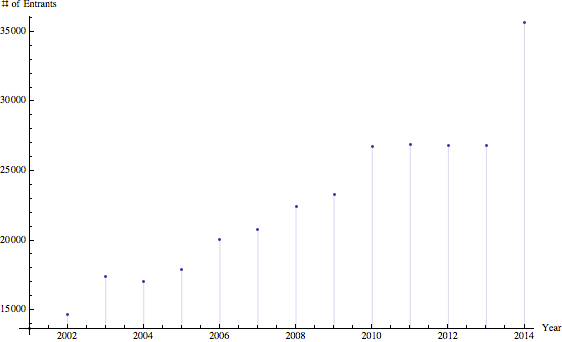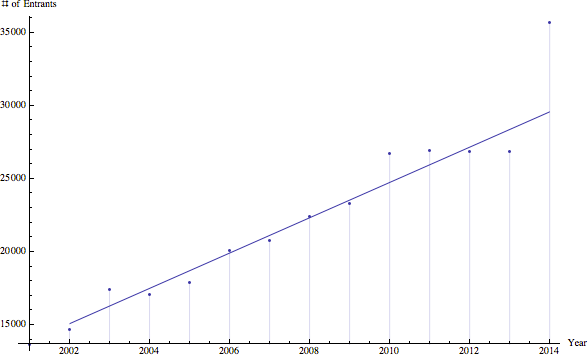How the 2013 Boston Marathon Bombings Affected This Year’s Attendance
A year ago, I logged a prediction (at 60% confidence) that this year’s Boston Marathon attendance would be lower than the previous year’s as a result of the 2013 bombings.
Well, the numbers are in, and I wasn’t even close: Last year, 26839 people entered the race. This year? 35671 runners, about 33% growth. (In hindsight, what was I even thinking?)
I wanted to quantify just what sort of effect the bombings had on attendance, so I gathered all the data that’s readily available online, and plotted it:
You’ll notice that 2014 seems like a pretty clear outlier. Fitting a line to the data allows us to quantify what normal growth probably would have looked like in an alternate universe where there were no bombings:
Running the numbers, the difference between the predicted turn out and the observed turn out is an additional 6087 runners. You might wonder: what kind of economic windfall is that? Well, the 2012 marathon generated $137.5 million in revenue, some $5123 per runner. This means that the additional 6087 runners should generate an additional 31.2 million in revenue, or about a tenth of the cost of the bombings’s damage (at least according to one NBC estimate).
On Bad Publicity
But we should go back and ask, “What was wrong with my intuition a year ago such that I expected marathon attendance to decrease?” I suspect I underestimated just how compelling a message like, “2014: Let’s race against terror” or “Racing in loving memory of Martin William Richard” would be.
I think I was thinking along the lines of, “Well, people died. People will think it’s dangerous, so they won’t go.” But of course that didn’t happen. Maybe I overestimated just how irrational people are. They probably figured the odds of a second attack were tiny.
Or maybe the sort of media coverage you get when someone attacks your marathon is just surprisingly effective advertising. The Boston Marathon was not even on my radar a year ago, but I’m sitting here and talking about it now, and I’m confident I wouldn’t be otherwise, so it certainly got my attention.
The most relevant comparison I can think of is the 2012 theater shooting, which marred the release of The Dark Knight Rises. Given the growth in Boston Marathon attendance, we might expect — perversely — that the shootings would be good for sales.
This doesn’t appear to be the case. The movie brought in 30 million less in sales than expected, and a 2013 analysis in the Journal of Criminal Analysis reports that the “Aurora theater shooting resulted in striking declines for Cinemark (the targeted theater) as well as major US competitors, but had no impact on overseas theater chains.”
The most salient difference between the two is, I expect, timeframe. A year’s passing makes the bombings feel distant (at least to someone not directly involved) while the bulk of the expected ticket sales took place soon after the theater shootings.
Finally, you might wonder: is there any truth to this whole notion of “no such thing as bad publicity”? Well, sorta: a 2004 study found that any reviews, positive and negative, increased book sales. A 2010 sorta replication found that negative reviews increased sales, but only of mostly unknown authors. Bad reviews of well-known authors, in contrast, hurt sales.
The paper itself offers a few interesting tidbits, too, including:
A wine described “as redolent of stinky socks,” for example, saw its sales increase by 5% after it was reviewed by a prominent wine website (O’Connell 2006). Similarly, although the movie Borat made relentless fun of the country of Kazakhstan, Hotels.com reported a “300 percent increase in requests for information about the country” after the film was released (Yabroff 2006, p. 8).
But, in general, bad publicity is bad publicity and we should stop paying too much attention to questionable adages:
Negative publicity often hurts. When a rumor circulated that McDonald’s used worm meat in its hamburgers, sales decreased by more than 25% (Greene 1978). Coverage of musician Michael Jackson’s bizarre behavior and brushes with the law destroyed his career. Viacom Inc. Chairman Sumner Redstone estimated that negative publicity cost Mission Impossible 3 more than $100 million in ticket sales (Burrough 2006), and film pundits have suggested that it is “almost impossible to recover from bad buzz” (James 2006).
Academic research corroborates this sentiment and casts further doubt on the old adage that “any publicity is good publicity.” Negative publicity about a product has been shown to hurt everything from product and brand evaluation (Tybout et al. 1981, Wyatt and Badger 1984) to firm net present value and sales (Goldenberg et al. 2007, Reinstein and Snyder 2005). Negative movie reviews, for example, decrease box office receipts (Basuroy et al. 2003).
Further Reading
- If you want to use the data for anything, it’s available here.

